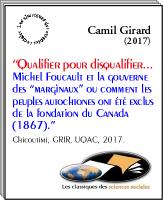|
Présentation du Rapport Bagot
par Camil Girard, historien.
Charles Bagot, 1844-1845, Report on the Affairs of the Indians in Canada, laid before the Legislative Assembly, 20th March, 1845, Appendix EEE, publish by order of Charles Bagot, Governor General of British North America, 8 Victoria.
 Keywords: Charles Bagot, Commissions of Inquiry, Act of Union 1840-1867, 1845, Canadian Indian Policy, “Indian” Laws, Reserves, Assimilation Project, Spoliation of Indigenous Peoples’ Territories. Keywords: Charles Bagot, Commissions of Inquiry, Act of Union 1840-1867, 1845, Canadian Indian Policy, “Indian” Laws, Reserves, Assimilation Project, Spoliation of Indigenous Peoples’ Territories.
* * *
Originally published without pagination or author, this document, which cannot be found in French and difficult to find in English, will finally be able to have a better distribution thanks to the director of Les Classiques des Sciences sociales of the Université du Québec à Chicoutimi (UQAC), the sociologist, Jean-Marie Tremblay.
How is it that this rare document, although known and quoted by Aboriginals and specialists, has not had a better circulation and has hardly ever been published or studied in depth.
What we call here the Bagot Report (1844-1845) is the equivalent for Aboriginals of what the Durham Report (Act of Union) was a few years earlier for French Canadians: results of investigations which aimed to justify the assimilation both Francophones conquered since 1760 and Aboriginals who had received special status by the Royal Proclamation of 1763 as well as a right to possession of their land..
This document was used by the administrators of the Canadian government (Act of Union, 1840-1867) who set up from 1847 (responsible government) the Canadian policy concerning Aboriginal Peoples. This policy, which is defined on the basis of discriminatory laws passed between 1850 and 1876 (Indian Act), created the status “Indian” as well as that of “reserves”. » Through its discriminatory laws against Indigenous Peoples, Canadian legislators forced the migration of Indigenous Peoples into “reserves” in order to be recognized as “Sauvages” or “Indians”, a generic and administrative term in which Indigenous Peoples and Nations will henceforth be identified by law. To be recognized as an "Indian" by the administrator of the Canadian government, you will have to leave your traditional territory, show that you are an "Indian" to the federal representative on the reserve, the one who will confirm your attachment to the "band” (Indian Act of 1985 continues this obligation not to belong to a nation but to a “band”).
By creating the reserves, the Canadian legislator appropriate without saying it clearly the traditional Territory of the Indigenous Peoples as well as their resources. Thus, the creation of the Confederate Canada of 1867, the Canada “Ad mare us que ad mare,” was prepared by taking possession of the Indigenous Territories while excluding the Indigenous Nations from the foundation (see: Girard, Brisson, PUL, 2014; 2018 and 2021) (see in particular for the discriminatory laws between 1850 and 1876, our 2018 book)..
Camil Girard,
Groupe de Recherche Histoire
Université du Québec à Chicoutimi (GRH-UQAC)
INRS-Culture et Société
 For an analysis of the context of the production of the report: For an analysis of the context of the production of the report:
Camil Girard, « Qualifier pour disqualifier… Michel Foucault et la gouverne des « marginaux » ou comment les peuples autochtones ont été exclus de la fondation du Canada (1867) », dans Marie Fall, Danielle Maltais, Suzanne Tremblay, Vivre-ensemble dans les régions du Québec : défis et enjeux contemporains, Groupe de recherche et d’intervention régionale (GRIR), Université du Québec à Chicoutimi, 2017. Disponible dans les Classiques des Sciences sociales, UQAC.
Références et lectures suggérées
Camil Girard, Carl Brisson, Alliances et Traités avec les peuples autochtones du Québec. L’Histoire de la Nation Wolastoqiyik Wahsipekuk. La nation malécite du Saint-Laurent, en préparation aux Presses de l’Université Laval, Québec, 2021.
Camil Girard, Carl Brisson, Reconnaissance et exclusion des peuples autochtones au Québec (Canada). Du Traité d’Alliance de 1603 à nos jours, les Presses de l’Université Laval, 2018. Version pdf en accès gratuit via le site des Presses de l’Université Laval.
Camil Girard, Carl Brisson, Nistassinan – Notre Terre. Alliance et souveraineté partagée du peuple innu au Québec. Des origines à nos jours, Québec, Les Presses de l’université du Québec. 2014. Collection Mondes autochtones. Version pdf en accès gratuit via le site des Presses de l’Université Laval.
Lavoie, Michel et Denis Vaugeois, 2010, L’impasse amérindienne. Trois commissions d’enquête à l’origine d’une politique de tutelle et d’assimilation : 1828-1858, Québec, Septentrion.
John Leslie, 1985, Commission of Inquiry into Indian Affairs in the Canadas, 1828-1858, Evolving a corporate memory for the Indian Department, Ottawa, Treaties and Historical Research Centre, Department of Indian Affairs and North department.
|

